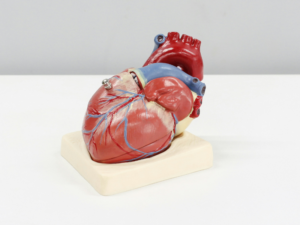Sijimol Mathew, DNP, APRN, ACNP-BC
Insulinomas originate from the uncontrolled growth of pancreatic beta cells. Chronic and recurrent hypoglycemia lowers the patient’s threshold to hypoglycemic insults; additionally, early morning hypoglycemia makes insulinoma difficult to detect at an early stage. Malignant insulinomas are rare but result in uncontrolled insulin secretion. Excessive insulin secretion and repeated hypoglycemia make it a potentially fatal disease.
Case Presentation
Mr. A presented with non-fasting hypoglycemia symptoms. For the past year, he has experienced suddenly becoming jittery, episodes of “splitting headaches” and difficulty concentrating in the morning, with improved symptoms after eating. He reports an episode of dizziness and loss of consciousness. He has seen a neurologist with the following results: nonspecific examination, normal computed tomography (CT) scan of the head, and regular basic alpha activity on electroencephalogram. The endocrinologist recommended a continuous glucose monitor; his recorded range was 40 to 50 mg/dL in the mornings and 60 to 70 mg/dL after lunch or dinner. Because of this persistent hypoglycemia, his endocrinologist expressed concerns for a possible insulinoma. He was admitted for recurrent symptomatic hypoglycemia and started on intravenous (IV) dextrose by continuous infusion to prevent risk of hypoglycemic coma.
Table 1. Mr. A’s Laboratory Values
| Parameter | Result |
| Cortisol | 16.35 mcg/dL |
| Cortisol baseline | 3.31 mcg/dL |
| Cortisol 30 minutes | 21.09 mcg/dL |
| Cortisol 60 minutes | 24.48 mcg/dL |
| C-peptide | 5.3 ng/mL |
| Insulin level | 15.8 μIU/mL |
| Beta-hydroxybutyrate (quantitative) | 0.2 mmol/L |
| Proinsulin | 190 pmol/L |
| Insulin-like growth factor 1 | 167 ng/mL |
| Insulin-like growth factor 2 | 604 ng/mL |
| Adrenocorticotropic hormone (ACTH) | 16 pg/mL |
Imaging
CT of the abdomen/pelvis with intravenous contrast found no definite evidence of a pancreatic mass.
Insulinoma Etiology and Epidemiology
Insulinoma is a solitary tumor with unknown etiology. It is benign in 90% of cases, with a risk of malignant potential.1 It can be associated with multiple endocrine neoplasia type 1 (MEN1), which is an autosomal dominant condition resulting from the inactivating mutation of the gene located on chromosome 11.2 The locations of insulinomas are often in the pancreas (90%) and 10% of them are found outside the pancreas (walls of the duodenum, ileum, jejunum, and splenic hilum).2,3 The incidence of insulinoma is around 1 to 4 per million per year.4
Signs and Symptoms
Insulinoma patients will often manifest symptoms described as the Whipple triad. Features include symptomatic hypoglycemia, plasma glucose levels <55 mg/dL, and reversal of symptoms after a high glucose meal.
Diagnostic Testing
The 72-hour fasting test is the gold standard for establishing the diagnosis of insulinoma.1 It tests the integrity of the patient’s own endogenous suppression of insulin in the face of hypoglycemia.5
| Table 2. Diagnostic Criteria1 · Blood glucose levels near or below 45 mg/dL · Concomitant insulin levels equal or greater than 6 μU/mL (43 pmol/L) · Elevated C-peptide levels (≥200 pmol/L) · Absence of sulfonylurea in plasma · Increased proinsulin level (≥25% or ≥22 pmol/L) |
Prescribed insulin does not contain C-peptide, which means measurements of serum C peptide assess pancreatic beta cell function.
Radiological imaging is used in localizing insulinoma for surgical planning. In 40% to 60% of cases the routine imaging studies fail to identify the insulinoma due to its small size. The sensitivity varies depending on imaging technique: 50% for transabdominal high-resolution ultrasonography, 82% to 94% for CT scan, 82% for MRI, 90% for positron emission tomography (PET) CT scan.6 Arterial stimulation and venous sampling (ASVS) and endoscopic ultrasound are shown to have higher sensitivity (65% and 100%, respectively).5
Management
- Surgical resection is the only curative treatment for insulinoma.2
- Medical therapy is used to prevent symptomatic hypoglycemia in patients with unresectable insulinoma.
- Diazoxide directly inhibits insulin release from beta cells via stimulation of α-adrenergic receptors. Diazoxide also inhibits cyclic adenosine monophosphate phosphodiesterase, which enhances glycogenolysis and releases glucose from the liver.5
- Octreotide, an analog of somatostatin, inhibits the secretion of insulin.2 Other agents, such as phenytoin (inhibits the release of insulin from beta cells), verapamil, propranolol, glucocorticoids, and glucagon, have been used either alone or in combination with other drugs to help control hypoglycemia symptoms.2
- Small frequent meals help to avoid hypoglycemia.5 Potential treatment options for metastatic disease include cytotoxic chemotherapy, targeted therapy, or targeted radiotherapy. Patients should be educated on hypoglycemic symptoms, medical alert bracelets, and quick corrections.
Conclusion
A patient with suspected insulinoma can present with unusual hypoglycemic symptoms. Keen clinical observation and proper laboratory testing are crucial in accurate diagnosis. Localization and surgical resection of localized tumors can cure the patient.

References
- Jia, W. (2018). Continuous Glucose Monitoring (W. Jia, Ed.; 1st ed. 2018.). Springer Singapore. https://doi.org/10.1007/978-981-10-7074-7
- La Rosa, S., & Sessa, F. (Eds.). (2015). Pancreatic Neuroendocrine Neoplasms: Practical Approach to Diagnosis, Classification, and Therapy (1st ed. 2015.). Springer International Publishing. https://doi.org/10.1007/978-3-319-17235-4
- Li, L., Zhao, R., Hong, H., Li, G., Zhang, Y., Luo, Y., Zha, Z., Zhu, J., Qiao, J., Zhu, L., & Kung, H. F. (2021). 68Ga-labelled-exendin-4: New GLP1R targeting agents for imaging pancreatic β-cell and insulinoma. Nuclear medicine and biology, 102-103, 87–96. https://doi.org/10.1016/j.nucmedbio.2021.10.001
- Mathur, A., Gorden, P., Libutti, S. Insulinoma. (2009). Surgical Clinics of North America, 89(5), 1105-1121, https://doi.org/10.1016/j.suc.2009.06.009.
- Zhuo F, Anastasopoulou C. Insulinoma. [Updated 2023 Jun 20]. In: StatPearls [Internet]. Treasure Island (FL): StatPearls Publishing; 2023 Jan-. Available from: https://www.ncbi.nlm.nih.gov/books/NBK544299/
- Murakami, T., Fujimoto, H., Hamamatsu, K., Yamauchi, Y., Kodama, Y., Fujita, N., Fujikura, J., Shimizu, Y., Nakamoto, Y., Kimura, H., Saji, H., & Inagaki, N. (2021). Distinctive detection of insulinoma using [18F]FB(ePEG12)12-exendin-4 PET/CT. Scientific reports, 11(1), 15014. https://doi.org/10.1038/s41598-021-94595-6







